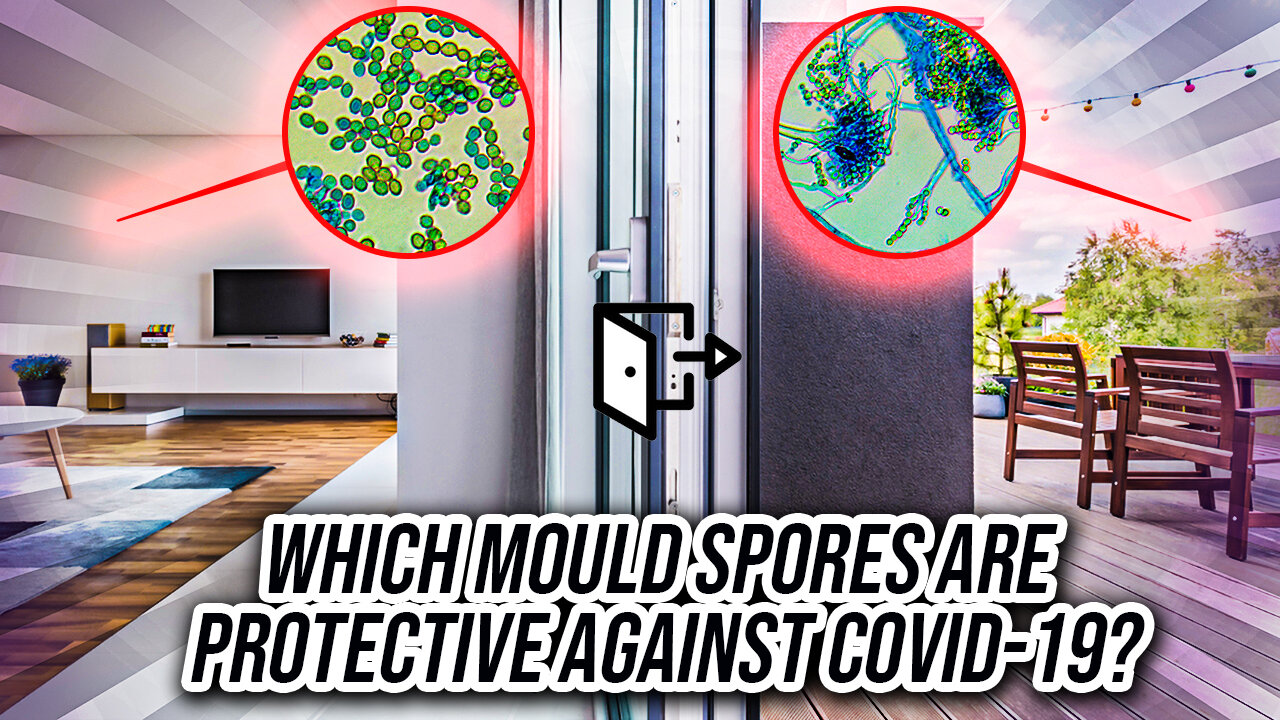Premium Only Content

Which Mould Spores are Protective Against COVID-19?
Fungi grow everywhere, including the soil, in water and on plants on us, and in other organisms and of course inside our homes. Back in the 1990s people thought there were about 1.5M fungi on earth because only some of them had been described. However, more recent genetic sequencing tools put the total number of fungal species on Earth at over 5 Million. When we think about research on fungal diversity it’s a bit like the concept of the microbiome in our gut and similarly is referred to as the mycobiome.
The purpose of today's talk is to discuss the relationship that we have with fungi in the built environment or the mycobiome of our homes. To do this, I want to focus attention on a groundbreaking pre-print paper that came out on the 16th of December 2021 on medRxiv. This looked at the relationship between specific types of fungi and how Species diversity can be used to predict the seriousness of influenza type infections like COVID-19 mortality.
When you think about the over 5M fungal species that exist on the planet and juxtapose this against the approximate 2000 mushrooms species we might eat as food - there really are a lot of chance and probable possibilities for us to come into contact with these microorganisms in our everyday lives.
This new paper that came out from the Lawrence Berkeley National Laboratory is quite an eye-opener because it looked at how fungal communities inside 1135 homes in the United States is connected with something called the Infection Fatality Ratio (IFR) which describes the number of deaths caused by COVID-19 per 1000 coronavirus infections.
Their research showed that an increased fungal diversity especially for specific Species of indoor fungi versus outdoor fungi (Beta diversity) was associated with a reduced infection fatality ratio. Their hypothesis was premised on the known fact that (i) humans probably have an evolutionary adaptation to maintaining semi-stable close contact with microbes such as fungi without major adverse impact. As well, (ii) it’s known that early life exposure to certain types of bacteria, yeasts, and fungi actually stimulates the immune system.
In their paper, they looked at whether there was a correlation between certain Species of fungi and adverse outcomes from COVID? And amazingly they found that “yes” there is!
They found that something called the beta diversity assessed from a comparison between fungal spore types collected outdoors and then inside the home living environment was of fundamental importance.
To understand this concept, I need to explain what beta diversity is because this is a basic principle needed to understand this publication. [This presentation and the references in the show notes below detail exactly how to do this]. However, the key result is that: high diversity of outdoor fungi when also present indoors is associated with a suppression effect for COVID-19 mortality.
This means that collecting spore trap measurements from the outdoors and indoors is very important for predicting adverse events like mortality from COVID-19 and emphasizes the importance of the environment on human illness. Now it’s not just the raw numbers of fungi, but the overlap of which types are present outdoors and also found indoors which defines different aspects of Species richness and diversity.
The research showed that at least four of the following seven fungal genera have a key role in suppressing coronavirus infections. These were: Alternaria, Aspergillus, Epicoccum, Eurotium, Toxicocladosporium and Wallemia as well as a novel Mycosphaerellaceae fungus.
You could argue that simply airing out your property will naturally bring fresh outdoor air containing mould spores indoors. So, wouldn’t that automatically select for the correct beta diversity ratio that’s better for your health?
On the surface, you'd be right to conclude this. However, I've personally done 1000s of indoor air quality inspections over the years and many homes have hidden mould problems that contribute to poor indoor air quality. This is often caused by water damage and dampness and in most of these cases, there is a skewed distribution of fungi indoors that’s very different to the outdoors.
This publication is extremely important because it shows a correlation effect between bioaerosol counts especially mould spores and respiratory disease outcomes. The key takeaway here is that COVID-19 mortality is suppressed inside homes where the outdoor fungi occur indoors at very similar levels.
When the skewness or difference between the outdoor: indoor diversity changes, or when the indoor fungi are significantly different to the outdoors, then COVID-19 mortality increases.
These researchers found that fungal beta diversity was a much stronger correlate for adverse COVID-19 outcome as age. For example, older persons have worse COVID-19 outcomes, and this paper says that fungal beta diversity in the wrong direction is also bad for your health. The authors stress the method is unlikely to be restricted only to coronavirus but could extend to surveillance of other allergic and viral diseases. This research, therefore, underscores the importance of fungal biosurveillance in the built environment to improve public health outcomes.
REFERENCES:
The impact of environmental mycobiomes on geographic variation in COVID-19 mortality. December 16, 2021. Joshua Ladau, Katrina Abuabara, Angelica M. Walker, Marcin P. Joachimiak, Ishan Bansal, Yulun Wu, Elijah B. Hoffman, Chaincy Kuo, Nicola Falco, Jared Streich, Mark J. van der Laan, Haruko M. Wainwright, Eoin L. Brodie, Matthias Hess, Daniel Jacobson, James B. Brown
medRxiv 2021.12.14.21267549; doi: https://doi.org/10.1101/2021.12.14.21267549
Blackwell M. The fungi: 1, 2, 3 ... 5.1 million species? Am J Bot. 2011 Mar;98(3):426-38. doi: 10.3732/ajb.1000298. Epub 2011 Mar 2. PMID: 21613136.
Li, H., Tian, Y., Menolli, N., Ye, L., Karunarathna, S., & Perez‐Moreno, J. et al. (2021). Reviewing the world's edible mushroom species: A new evidence‐based classification system. Comprehensive Reviews In Food Science And Food Safety, 20(2), 1982-2014. doi: 10.1111/1541-4337.12708
Koenigsberg, A. (2021). How to Calculate Species Evenness. Retrieved 23 December 2021, from https://sciencing.com/calculate-species-evenness-2851.html
Bezerra JDP, Sandoval-Denis M, Paiva LM, et al. New endophytic Toxicocladosporium species from cacti in Brazil, and description of Neocladosporium gen. nov. IMA Fungus. 2017;8(1):77-97. doi:10.5598/imafungus.2017.08.01.06
Sandoval-Denis M, Sutton DA, Martin-Vicente A, Cano-Lira JF, Wiederhold N, Guarro J, Gené J. Cladosporium Species Recovered from Clinical Samples in the United States. J Clin Microbiol. 2015 Sep;53(9):2990-3000. doi: 10.1128/JCM.01482-15. Epub 2015 Jul 15. PMID: 26179305; PMCID: PMC4540897.
Videira, S., Groenewald, J., Nakashima, C., Braun, U., Barreto, R., de Wit, P. and Crous, P., 2017. Mycosphaerellaceae – Chaos or clarity?. Studies in Mycology, 87, pp.257-421.
Baselga, A., 2015. What is Beta Diversity?. [online] Methods Blog. Available at: [Accessed 23 December 2021].
-
 2:03:25
2:03:25
The Quartering
4 hours agoNYC Lunatic Update, Doxxing Website For Men OWNED, Walmart Stabber Update, 2 Men Buy Baby...
111K21 -
 2:48:20
2:48:20
Barry Cunningham
4 hours agoSYDNEY SWEENEY PROVES PRESIDENT TRUMP IS RIGHT! EVERYTHING WOKE TURNS TO....
26.9K8 -
 LIVE
LIVE
The HotSeat
1 hour ago💥 Chuck Schumer MELTS DOWN Over Voter ID! Are Democrats Really This Delusional?
649 watching -
 18:15
18:15
Clownfish TV
12 hours agoCartoon Network Just Got DROPPED!
5.78K12 -
 1:13:26
1:13:26
Russell Brand
5 hours agoShooting RAMPAGE In NYC + Trump HUMILIATES Starmer During UK Visit - SF622
161K53 -
 10:21
10:21
Colion Noir
7 hours agoCaught On Camera: Armed Veteran With AR-15 Shoots Man Who Fires Into Crowd With Drum Magazine
29.7K18 -
 20:37
20:37
Degenerate Jay
6 hours ago $0.46 earnedThe Fantastic Four: First Steps Review - Fantastic Or Failure?
11.7K2 -
 6:43:48
6:43:48
JuicyJohns
8 hours ago $3.38 earned🟢#1 REBIRTH PLAYER 10.2+ KD🟢 !loadout
71.4K2 -
 1:01:52
1:01:52
Sean Unpaved
4 hours agoRyne Sandberg's Legacy, Madden's 99 Club, NIL's Locker Room Heat, & Wilkins' Kiss-and-Run
32.3K1 -
 6:29
6:29
Clickbait Wasteland
18 hours ago $1.18 earnedCUOMO vs ZOHRAN: Who do New Yorkers Want as the Next Mayor?
24.9K11